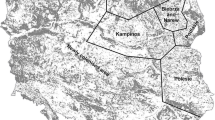Summary
As a preliminary to a population study using markrelease-recapture techniques, specimens of the Satyrid buttfly Melanargia galathea (L.) were subjected to a number of marking and capture techniques. Although the adults are thought to display both aposematic and cryptic coloration, the use of marks of different sizes and colours had no significant effect on recapture frequencies. However, repeated disturbance due to capture was found to significantly reduce recapture frequency. The influence of the different techniques on recapture frequencies could not be detected reliably by excessively low recapture rates, or by comparisons to Poisson distributions. It is suggested that these comparisons are of limited value as measures of the suitability of a marking or handling scheme. Subsequent work showed that capture affected recapture rates of several other species. Moreover, these effects could not be readily predicted from knowledge of the biology of these species. The implications of these findings are discussed.
Similar content being viewed by others
References
Bishop JA, Sheppard PM (1973) An evaluation of two capture-recapture models using the technique of computer stimulation. In: MS Bartlett, RW Hiorns (eds), The mathematical theory of the dynamics of biological populations. Academic Press, N.Y. and London, p 235–252
Blower JG, Cook LM, Bishop JA (1981) Estimating the size of animal populations. George Allen and Unwin, London
Brown IL, Ehrlich PR (1980) Population biology of the checkerspot butterfly Euphydryas chalcedona. Structure of the Jasper Ridge colony. Oecologia (Berl) 47:239–251
Cook LM, Thomason EW, Young AM (1976) Population structure, dynamics and dispersal of the tropical butterfly Heliconius charitonius. Anim Ecol 45:851–863
Craig CC (1953) On the utilisation of marked specimens in estimating populations of flying insects. Biometrika 40:170–176
Dobson RM, Stephenson JW, Lofty JR (1958) A quantitative study of a population of wheat bulb fly, Leptohylemyia coarctata (Fall.), in the field. Bull ent Res 49:95–111
Douwes P (1970) Size of, gain to and loss from a population of adult Heodes virgaureae L. Ent Scand 1:263–281
Dowdeswell WH, Fisher RA, Ford EB (1940) The quantitative study of populations in the Lepidoptera. 1. Polyommatus icarus Rott. Ann Eugen Lond 10:123–136
Ehrlich PR, Gilbert LE (1973) Population structure and dynamics of the tropical butterfly, Heliconius ethilla. Biotropica 5:69–83
Fisher RA, Ford EB (1947) The spread of a gene in natural conditions in a colony of the moth Panaxia dominula L. Heredity 1:143–174
Hartley PHT (1954) Back garden ornithology. Bird Study 1:18–27
Jackson CHN (1948) The analysis of a tsetse-fly population. III. Ann Eugen, Lond 14:91–108
Jolly GM (1965) Explicit estimates from capture-recapture data with both death and immigration — stochastic model. Biometrika 55:225–247
Lincoln FC (1930) Calculating waterfowl abundance on the basis of banding returns. U.S.D.A. Circ 118:1–4
Manly BFJ, Parr MJ (1968) A new method for estimating population size, survivorship, and birth rate from capture-recapture data. Trans Soc Brit Ent 18:81–89
Moore NW (1975) Butterfly transects in a linear habitat 1964–1973. Ent Gaz 26:71–78
Pollard E (1977) A method for assessing changes in abundance of butterflies. Biol Conserv 12:115–134
Pollard E, Elias DO, Skelton MJ, Thomas JA (1975) A method of assessing the abundance of butterflies in Monks Wood National Nature Reserve in 1973. Ent Gaz 26:79–88
Roff DA (1973) An examination of some statistical tests used in the analysis of mark-recapture data. Oecologia (Berl.) 12:35–54
Seber GAF (1965) A note on the multiple-recapture census. Biometrika 52:249–259
Sharp MA, Parks DR (1973) Habitat selection and population structure in Plebejus saepiolus Boisduval (Lycaenidae). J Lep Soc 27:17–21
Singer MC, Wedlake P (1981) Capture does affect probability of recapture in a bufferfly species. Ecol Ent 6:215–216
Skeleton MJ, Heath J (1975) Insect distribution maps scheme, Lepidoptera Rhopalocera, Provisional distribution maps. Biological Records Centre, Monks Wood
Sokal RR, Rohlf FJ (1969) Biometry. W.H. Freeman & Co., San Francisco
Southwood TRE (1978) Ecological methods with particular reference to the study of insect populations. 2nd ed. Chapman and Hall, London
Author information
Authors and Affiliations
Rights and permissions
About this article
Cite this article
Morton, A.C. The effects of marking and capture on recapture frequencies of butterflies. Oecologia 53, 105–110 (1982). https://doi.org/10.1007/BF00377143
Received:
Issue Date:
DOI: https://doi.org/10.1007/BF00377143




